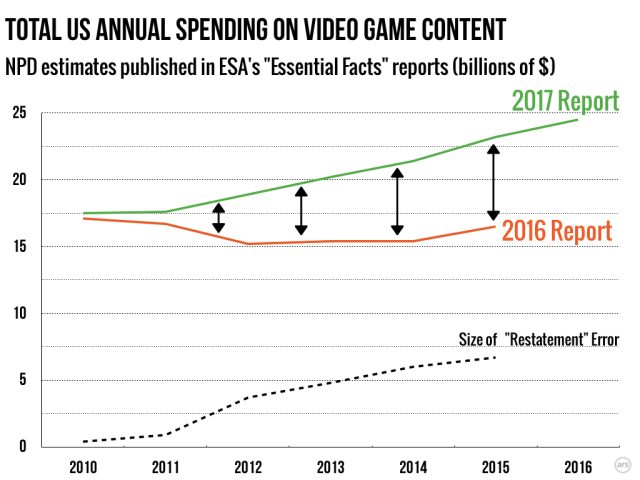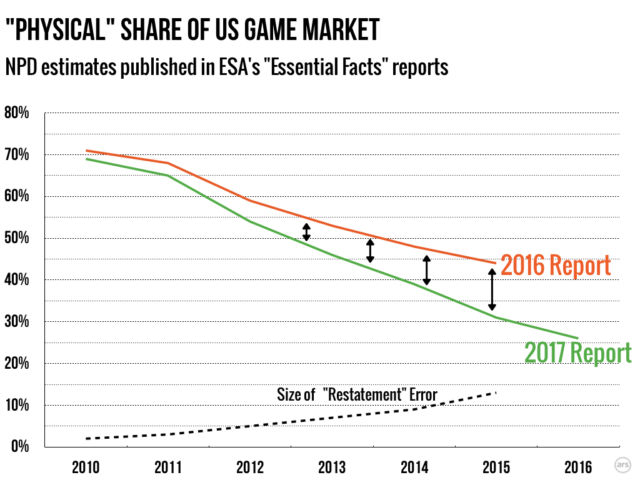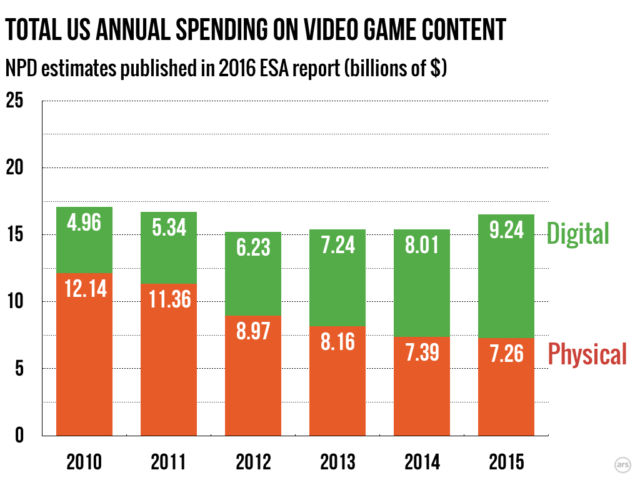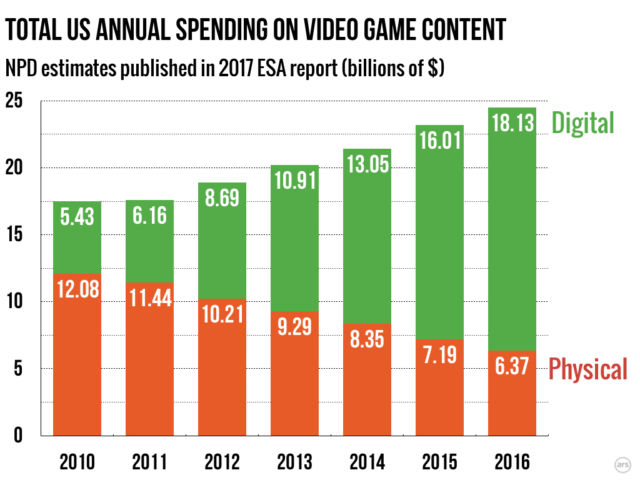
Fig. 1: A year ago, NPD thought US game market revenue had been pretty flat. Now, the tracking firm realizes the market has been growing consistently for years.
Fig. 1: A year ago, NPD thought US game market revenue had been pretty flat. Now, the tracking firm realizes the market has been growing consistently for years.
Fig. 1: A year ago, NPD thought US game market revenue had been pretty flat. Now, the tracking firm realizes the market has been growing consistently for years.
Fig. 2: The “physical” share of the US gaming market has been plummeting even faster than we thought, according to NPD’s new numbers.
Fig. 3: In the 2016 report, increasing digital sales were largely filling in the gap left by slowly declining physical sales.
Fig. 4: In the 2017 report, physical sales are an increasingly tiny piece of a pie that’s growing steadily thanks to digital revenue.
Last year, the Entertainment Software Association’s annual “Essential Facts” report suggested that the US game industry generated $16.5 billion in “content” sales annually (excluding hardware and accessories). In this year’s report, that number had grown to a whopping $24.5 billion, a nearly 50-percent increase in a span of 12 months.
No, video games didn’t actually become half again as popular with Americans over the course of 2016. Instead, tracking firm NPD simply updated the way it counts the still-shadowy world of digital game sales. This “restatement” of the US game industry’s true size helps highlight just how much the game industry at large has transitioned from a business based on physical goods to one dominated by digital downloads and online purchases.
You can see the dramatic changes in NPD’s industry estimates for yourself by looking at the ESA’s “Essential Facts About The Computer And Video Game Industry.” Between the 2016 edition and the newly released 2017 edition of the report, “total consumer spending” for the past few years has changed enormously, as you can see in the graph above (Fig. 1) and the table below.
| Year | 2016 Report | 2017 Report | Diff. | % diff. |
|---|---|---|---|---|
| 2010 | 17.1 | 17.5 | 0.4 | 2.34% |
| 2011 | 16.7 | 17.6 | 0.9 | 5.39% |
| 2012 | 15.2 | 18.9 | 3.7 | 24.34% |
| 2013 | 15.4 | 20.2 | 4.8 | 31.17% |
| 2014 | 15.4 | 21.4 | 6 | 38.96% |
| 2015 | 16.5 | 23.2 | 6.7 | 40.61% |
| 2016 | N/A | 24.5 | N/A | N/A |
Table 1: Annual spending on US game content (in billions of dollars. Source: NPD)
This isn’t a small difference—for the 2015 calendar year, the old and the new numbers are separated by over 40 percent. More than that, while the old numbers show the US video game market declining slightly in recent years, the updated numbers show the industry growing at an annual rate of about five to eight percent since 2012. The change brings NPD numbers more in line with NewZoo’s $23.5 billion estimate for the US game market in 2016.
What caused the discrepancy in these historical estimates? I reached out to NPD and got the following explanation from spokesperson David Riley:
The numbers have been restated to account for better visibility on mobile and digital full games and DLC spending. The acquisition of EEDAR, data informed from DLP [a “digital panel” of data directly from publishers], and re-sizing PC DLC spending is what led to the restatements.
In other words, until very recently, NPD didn’t have a very accurate idea of just how much US gamers were spending on game downloads and DLC across consoles, PC, and mobile phones. Only by getting new data from publishers and other sources did NPD begin to realize just how much they were underestimating the impact that non-physical games were having on the market.








